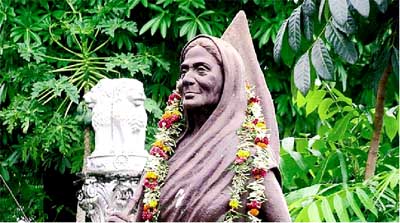Matangini Hazra was a remarkable woman for her time. She was born in 1869 at a place called Hogla, close to Tamluk. She was the daughter of an impoverished farmer who could not afford to send her to school, while there is little publicly available information about her early years. She was forced to marry Trilochan Hazra, a 60-year-old man from the Medinipur village of Alinan, at the age of 12 years because she lacked the resources to raise a respectable dowry. Matangini Hazra was widowed and childless by the time she was 18 years. She moved back to her parents’ village after being widowed and having no children, but she decided to keep a separate business for herself. She helped those in her neighbourhood for the majority of the following few years. She wasn’t certain of her plans for the future at that time.
She became actively involved in the Indian Independence Movement in 1905, drawing motivation from Mahatma Gandhi. The involvement of women in the freedom struggle in Midnapore was a noteworthy aspect. And among them was Matangini. Her life’s pivotal moment didn’t occur until a few years later, though. To raise awareness about the political condition of the country, on January 26, 1932, local residents marched in a parade. She emerged from her hut and joined them as it passed by. Matangini, at 62 years old, promised to fight for India’s freedom from British rule. There was no turning back for her. Later on, particularly during the Salt Satyagraha, she actively participated in Mahatma Gandhi’s Civil Disobedience Movement.
She participated in the production of salt in the village of Alinan, where her late husband was from. She was then taken into custody for breaking British salt regulations.
The authorities forced the elderly woman to travel a great distance as punishment. Later, she took part in the campaign to abolish the chowkidari tax. Matangini was detained once more and sentenced to a six-month prison term at Baharampur jail while participating in a march toward the courthouse in protest of the governor’s severe decision to punish all agitators.
She led 6,000 supporters, largely women, in taking control of the Tamluk police station on September 29. The Crown police ordered the march to dissolve when it got close to the town, invoking Section 144 of the Indian Penal Code. A bullet struck courageous Matangini as she moved forward and appealed the cops not to shoot at the gathering
Following her release, she actively participated in the local chapter of the Indian National Congress. She successfully moved to making her own khadi on a charkha. After a smallpox epidemic broke out, she devoted her entire time to care for the ailing adults, children, and infants. She was hurt while attending the Sub-Divisional Congress Conference at Serampore in 1933 when the police charged the protesters with batons. Hazra has been characterised as a fervent advocate for independence. In such a 1933 incident, Hazra participated in a freedom march that was organised in the district capital during a sweltering afternoon. Its final destination was Governor Sir John Anderson’s palace in Tamluk, the capital of Bengal. Anderson himself stood steadfastly on his balcony and observed the march detachedly, as though it were a cricket match or some sort of native ceremony in progress. Matangini led the parade while carrying the freedom flag aloft. She abruptly broke past the barricade as they drew nearer to the governor’s balcony, dodging the soldiers while waving her banner and shouting, “Go back, Laat Sahib.” For this audacious act, British police violently beat up and injured Hazra. She received a harsh six-month sentence for her audacity.
Local Congress members intended to occupy numerous Midnapore district police stations and government buildings in August 1942 under the auspices of the Quit India Movement. Matangini, who was 73, took the initiative. She led 6,000 supporters, largely women, in taking control of the Tamluk police station on September 29. The Crown police ordered the march to dissolve when it got close to the town, invoking Section 144 of the Indian Penal Code. A bullet struck courageous Matangini as she moved forward and appealed the cops not to shoot at the gathering.
She continued on, holding the tricolour high, and exhorting everyone to do the same. Despite being shot numerous times, she continued to shout Vande Mataram. Later, they discovered her motionless, limp body lying in a bloody pool. However, the tricolour was still flying triumphantly. The noble heart had made sure that the flag, which stands for the spirit of freedom, was preserved even in death! Her “martyrdom for the nation” was celebrated by the parallel Tamluk administration, which was able to continue operating for two more years before being abolished in 1944 at Gandhi’s request. When India attained independence in 1947, many streets, colonies, and schools were given Hazra’s name, notably a lengthy section of Hazra Road in Kolkata. In 1977, Hazra’s statue was erected in Kolkata, the first city in independent India to do so. The place in Tamluk where she was executed as a martyr now has a statue there. The postal service released a number of postage stamps in 2002 to mark the 60th anniversary of the Quit India Movement. One of them included a replica of Matangini Hazra on a five rupee postage stamp. After this well-known revolutionary, the Shahid Matangini Hazra Government College for Women was founded in Tamluk, Purba Medinipur, in 2015.




















Comments